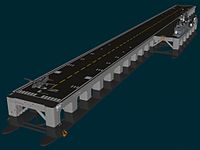
Photo from wikipedia
Abstract The Norwegian Public Road Administration (NPRA) is currently developing the E39 ferry-free project, in which several floating bridges will be built across deep and wide fjords. In this study,… Click to show full abstract
Abstract The Norwegian Public Road Administration (NPRA) is currently developing the E39 ferry-free project, in which several floating bridges will be built across deep and wide fjords. In this study, we consider the floating bridge that was an early concept for crossing the Bjornafjorden with a width of about 4600 m and with a depth of more than 500 m. The floating bridge concept is a complex end-anchored curve bridge, consisting of a cable-stayed high bridge part and a low bridge part supported by 19 pontoons. It has a number of eigen-modes, which can be excited by wave loads. Wave loads and their effects should thus be properly modeled and assessed. Therefore, the effect of hydrodynamic load modeling are investigated in homogeneous wave conditions, including varying water depth at the ends of the bridge, viscous drag force on pontoons, short-crestedness and second order wave loads. It is found that the varying water depth has negligible effect, while the other features are important to consider. Second order difference-frequency wave loads contribute significantly to sway motion, axial force and strong axis bending moments along the bridge. However, these effects can be reduced by viscous drag forces, which implies that an appropriate model of viscous drag force effect on the pontoons is important. short-crested waves greatly affect the heave motion and weak axis bending moment. All these considerations on hydrodynamic load modeling are further applied to analyze the wave load effect of a floating bridge in a fjord considering inhomogeneous waves [1].
Journal Title: Marine Structures
Year Published: 2018
Link to full text (if available)
Share on Social Media: Sign Up to like & get
recommendations!